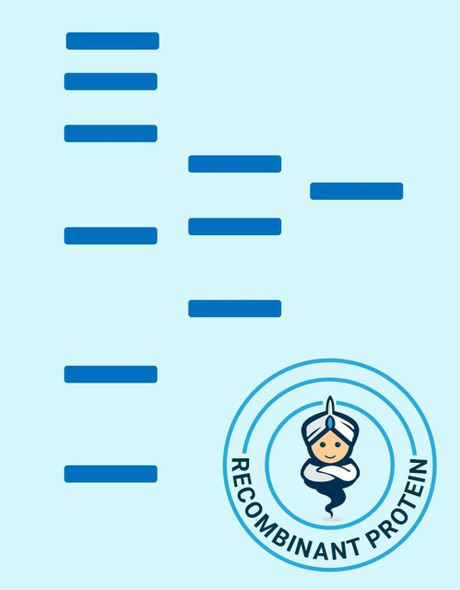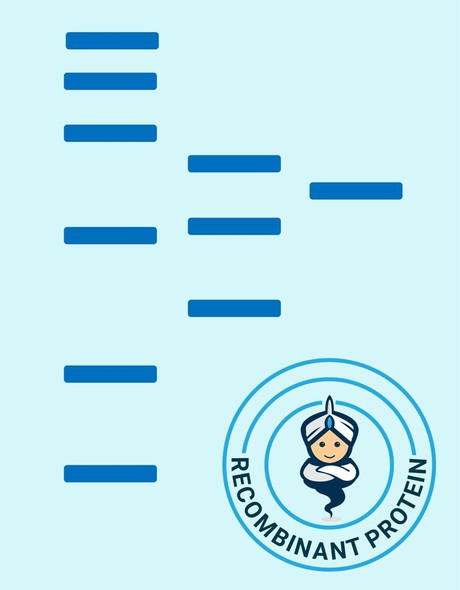CD Antigens Recombinant Proteins
Human CD1B Recombinant Protein (RPPB3011)
- SKU:
- RPPB3011
- Product Type:
- Recombinant Protein
- Species:
- Human
- Uniprot:
- P29016
- Research Area:
- CD Antigens
Description
| Product Name: | Human CD1B Recombinant Protein |
| Product Code: | RPPB3011 |
| Size: | 10µg |
| Species: | Human |
| Target: | CD1B |
| Synonyms: | T-cell surface glycoprotein CD1b, CD1B, CD1, CD1A, R1. |
| Source: | Escherichia Coli |
| Physical Appearance: | Sterile Filtered clear solution. |
| Formulation: | CD1B protein solution (0.5mg/ml) containing 20mM Tris-HCl buffer (pH 8.0), 0.2M NaCl, 20% glycerol and 1mM DTT. |
| Stability: | Store at 4°C if entire vial will be used within 2-4 weeks. Store, frozen at -20°C for longer periods of time. For long term storage it is recommended to add a carrier protein (0.1% HSA or BSA).Avoid multiple freeze-thaw cycles. |
| Purity: | Greater than 90.0% as determined by SDS-PAGE. |
| Amino Acid Sequence: | MGSSHHHHHH SSGLVPRGSH MGSMSEHAFQ GPTSFHVIQT SSFTNSTWAQ TQGSGWLDDL QIHGWDSDSG TAIFLKPWSK GNFSDKEVAE LEEIFRVYIF GFAREVQDFA GDFQMKYPFE IQGIAGCELH SGGAIVSFLR GALGGLDFLS VKNASCVPSP EGGSRAQKFC ALIIQYQGIM ETVRILLYET CPRYLLGVLN AGKADLQRQV KPEAWLSSGP SPGPGRLQLV CHVSGFYPKP VWVMWMRGEQ EQQGTQLGDI LPNANWTWYL RATLDVADGE AAGLSCRVKH SSLEGQDIIL YWRNPTSIGS |
CD1B belongs to CD1 family of transmembrane glycoproteins, which are structurally associated with the MHC proteins and form heterodimers with the beta-2-microglobulin. CD1B includes one Ig-like domain. CD1B is an antigen-presenting protein which connects self and nonself lipid and glycolipid antigens and displays them to T-cell receptors on natural killer T-cells.
CD1B Human Recombinant produced in E.Coli is a single, non-glycosylated polypeptide chain containing 310 amino acids (18-303a.a.) and having a molecular mass of 34.2kDa.CD1B is fused to a 24 amino acid His-tag at N-terminus & purified by proprietary chromatographic techniques.
| UniProt Protein Function: | CD1B: Antigen-presenting protein that binds self and non-self lipid and glycolipid antigens and presents them to T-cell receptors on natural killer T-cells. 2 isoforms of the human protein are produced by alternative splicing. |
| UniProt Protein Details: | Protein type:Membrane protein, integral Chromosomal Location of Human Ortholog: 1q23.1 Cellular Component: cell surface; plasma membrane Molecular Function:beta-2-microglobulin binding; endogenous lipid antigen binding; exogenous lipid antigen binding; protein binding Biological Process: antigen processing and presentation, exogenous lipid antigen via MHC class Ib; regulation of immune response |
| NCBI Summary: | This gene encodes a member of the CD1 family of transmembrane glycoproteins, which are structurally related to the major histocompatibility complex (MHC) proteins and form heterodimers with beta-2-microglobulin. The CD1 proteins mediate the presentation of primarily lipid and glycolipid antigens of self or microbial origin to T cells. The human genome contains five CD1 family genes organized in a cluster on chromosome 1. The CD1 family members are thought to differ in their cellular localization and specificity for particular lipid ligands. The protein encoded by this gene localizes to late endosomes and lysosomes via a tyrosine-based motif in the cytoplasmic tail, and requires vesicular acidification to bind lipid antigens. [provided by RefSeq, Jul 2008] |
| UniProt Code: | P29016 |
| NCBI GenInfo Identifier: | 115962 |
| NCBI Gene ID: | 910 |
| NCBI Accession: | P29016.1 |
| UniProt Secondary Accession: | P29016,Q5TDK9, Q5TDL0, Q9UMM2, |
| UniProt Related Accession: | P29016 |
| Molecular Weight: | 30,740 Da |
| NCBI Full Name: | T-cell surface glycoprotein CD1b |
| NCBI Synonym Full Names: | CD1b molecule |
| NCBI Official Symbol: | CD1B�� |
| NCBI Official Synonym Symbols: | R1; CD1; CD1A�� |
| NCBI Protein Information: | T-cell surface glycoprotein CD1b |
| UniProt Protein Name: | T-cell surface glycoprotein CD1b |
| UniProt Synonym Protein Names: | CD_antigen: CD1b |
| Protein Family: | T-cell surface glycoprotein |
| UniProt Gene Name: | CD1B�� |
| UniProt Entry Name: | CD1B_HUMAN |






